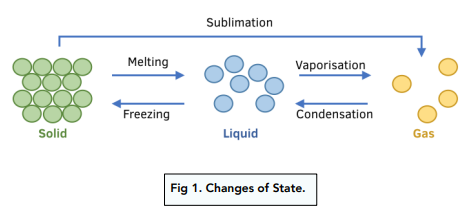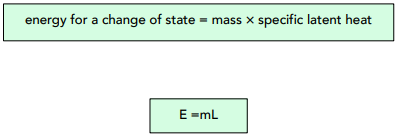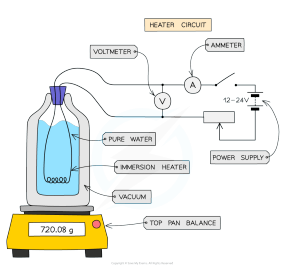Specific Latent Heat Calculations (GCSE Physics)
Changes of State
Latent heat is needed to change states. When we want to change the state of a substance, we have to use energy called latent heat.
This latent heat is used to describe the energy transferred into or out of the substance.
Below, we can see the energy changes between the states. This is the same diagram that we have seen previously. All of these state changes will require latent heat.

Specific Latent Heat
Defining Specific Latent Heat
The specific latent heat of a substance is the amount of energy required to change the state of one kilogram of the substance with no change in temperature.
Specific Latent Heat vs. Specific Heat Capacity
Although the definition of specific heat capacity seems very similar to the definition of specific latent heat, there is one key difference.
- Specific heat = energy needed to change one kilogram of a material by 1°C.
- Latent heat = energy needed to change the state (gas, liquid, solid) of one kilogram of material.
Types of Specific Latent Heat
There are two types of specific latent heat:
The specific latent heat of fusion is the energy when we convert from a solid to a liquid, or from a liquid to a solid.
The specific latent heat of vaporisation is the energy when we convert from a gas to a liquid, or from a liquid to a gas.
Calculating Specific Latent Heat
We can calculate specific latent heat by rearranging the following formula:

Where:
- energy, E, in joules, J
- mass, m, in kilograms, kg
- specific latent heat, L, in joules per kilogram, J/kg
Specific latent heat is the energy needed per kg for a state change. So to work out the energy needed for a state change, we just need to multiply specific latent heat (energy per kg) by the number of kgs.
Question: Calculate the energy transferred to the surroundings as 0.40 kg of stearic acid changed state from liquid to solid. The specific latent heat of fusion of stearic acid is 199 000 J / kg.
1. Write out the equation.
E =mL
2. Substitute in the numbers.
E = 0.40 x 199 000
E = 79 600 J
Measuring Specific Latent Heat
You need to know how to describe an experiment to measure the specific latent heat for steam and ice.
- Gather your equipment. You will need a vacuum flask containing pure water, a top pan balance, an immersion heater, a power source, a voltmeter, an ammeter and a stopwatch.
- Record the mass. Measure and take note of the mass of the vacuum flask containing pure water.
- Add the heater. Place the immersion heater into the water in the flask and connect the heater to a power supply.

- Heat the water. The water should boil should begin to boil after the power supply has been turned on.
- Take measurements. Using the voltmeter and ammeter, record the potential difference and current respectively. This should be done multiple times for 5 minutes (measured using the stopwatch).
- Switch off the power. After 5 minutes switch off the power supply.
- Calculate the mass of water which has evaporated. Measure the mass of the vacuum flask and pure water again. Subtract this value from when you first measured the flask.
- Calculate the heat supply. Use the equation E = IVt and substitute in all the values.
- Determine the specific latent heat. Use the equation we learnt above, E = mL. We now have the value of the heat supplied and the mass, therefore we can calculate the specific latent heat, L.
Specific latent heat is the amount of heat energy required to change the state of a substance (such as solid to liquid or liquid to gas) without changing its temperature.
Calculating specific latent heat helps us understand the amount of heat energy required to change the state of a substance, which is important in various real-life applications such as cooking, refrigeration, and air conditioning.
Specific latent heat can be calculated by dividing the amount of heat energy added or removed from the substance by the mass of the substance. The formula is:
Specific latent heat = (Heat energy) / (mass of substance)
Water, mercury, and ethyl alcohol are some common substances with high specific latent heat values.
The unit of measurement for specific latent heat is joules per kilogram (J/kg).
Using the correct unit is important because it ensures that the result accurately reflects the amount of heat energy required to change the state of the substance.
The specific latent heat of a substance affects its temperature change because the amount of heat energy required to change its state depends on its specific latent heat value. Substances with high specific latent heat values require more heat energy to change their state.






Still got a question? Leave a comment
Leave a comment